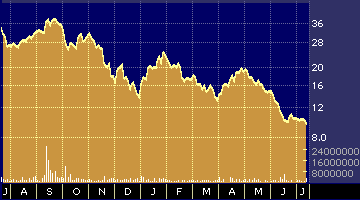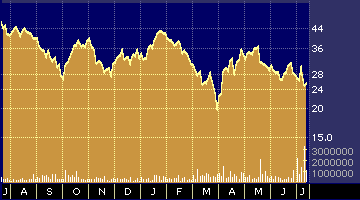
Web Site Offers Gurus’ Stock Picks
Web Site Offers Gurus’ Stock Picks
by Hal Plotkin
Silicon Valley Correspondent
When it comes to picking Internet stocks, conventional ideas about appropriate valuations have pretty much been thrown out the window. But sooner or later, the Internet mania could fade away like other once-sizzling investment crazes, such as tulip futures or biotechnology stocks.
If and when the long-feared Internet stock selloff does take place, stock-picking fundamentals are likely to re-emerge as a critical factor in investment decision-making. Those fundamentals, which assess basic stock-performance metrics, may well determine which stocks can rise phoenixlike from the ashes, and which ones might evaporate into the ether of the penny-stock listings.
But which fundamentals are important? And which stock-picking methodologies are best suited to your particular investment philosophy?
One of the best places to look for answers to those questions is the online guru-analysis stock-research service offered by West Hartford, Conn.-based Reese Group.
Reese Group’s free online service screens stocks according to criteria established by some of the world’s best-known stock-pickers. The famous stock-pickers don’t make the picks themselves. Instead, the site allows investors to obtain a dynamic appraisal of how individual stocks stack up based on current performance indicators using criteria preferred by well-known experts.
The service combines the collected wisdom of, among others, Peter Lynch, the world-renowned former Fidelity fund manager; Martin Zweig, chairman of the Zweig Funds; William O’Neil, an author and founder of Investor’s Business Daily; Forbes columnist Kenneth Fisher, who pioneered the price-to-sales ratio; quantitative-analysis champion J.P. O’Shaughnessy; value investor Benjamin Graham; and legendary contrarian investor David Dreman.
At the site, investors can find out when a particular stock would be of “strong interest,” “some interest,” or “no interest” based upon the criteria preferred by the individual analysts. A “no interest” rating doesn’t necessarily mean a particular analyst would sell the stock. It does, however, suggest the stock probably would not be anywhere near the top of that analyst’s buy list.
In the Internet sector, for example, on one recent day just seven of several hundred stocks analyzed were favored by three or more stock-picking methodologies. The leader, with support from five different methodologies, was Knight/Trimark Group Inc. {NITE}, which won favorable nods using methods popularized by Lynch, O’Neil, Zweig, and the Motley Fool and Olympic Internet Strategy online services.
Knight/Trimark Group, Inc. {NITE}
 |
|
||||||||||||
| Knight/Trimark 52-week stock performance | Analyst Ratings by Zacks | ||||||||||||
RSA Security Inc. {RSAS} came in second, winning support from four analysis methodologies: Lynch, O’Neil, Zweig, and the Olympic Internet Strategy.
RSA Security Inc. {RSAS}
 |
|
||||||||||||
| Knight/Trimark 52-week stock performance | Analyst Ratings by Zacks | ||||||||||||
Five technology stocks were favored by three or more stock-picking methods: Gemstar International Group Ltd. {GMST}, Intuit Inc. {INTU}, Microsoft Corp. {MSFT}, Network Appliance Inc. {NTAP}, and Network Solutions Inc. {NSOL}.
Dozens of other Internet stocks were favored by two or fewer analyst methodologies.
The difference between stock picks is related to the varying emphasis analysts place on particular performance metrics.
The Lynch methodology, for example, emphasizes a stock’s profit/earnings/growth ratio, earnings-per-share growth rate and the total debt-to-equity ratio, among other factors.
Zweig’s methodology, on the other hand, looks at some of those same issues but also gives weight to revenue growth in relation to EPS growth, earnings acceleration and persistence, and the rate of sales growth.
Contrarian Dreman’s technique, by contrast, looks for smaller-cap stocks, compares the price of a stock with its cash flow, book value, and dividend ratio, assesses a company’s pretax profit margins and overall yield, along with about a dozen other factors.
Somewhat alarmingly, there are quite a few very popular Internet stocks whose fundamentals were found lacking, at then-current price levels, by every one of the stock-picking methodologies detailed on the Reese Group’s guru analysis Web site. Those include Bluefly Inc. {BFLY}, Dr.Koop.com Inc. {KOOP}, E.piphany Inc. {EPNY}, Healtheon/WebMD Corp. {HLTH}, Kana Communications Inc. {KANA}, NextCard Inc. {NXCD}, and priceline.com, Inc. {PCLN}, among many others.
With the Nasdaq Composite Index at record highs and many people talking about the so-called “Internet bubble,” now might be a very good time for investors to see how their stock holdings, particularly their Internet stock holdings, measure up based on some leading rational and un-exuberant stock-picking methodologies.
It’s the kind of information you’ll probably want to have the day before, rather than the day after, the selling starts in earnest.
That is, if it ever does.


